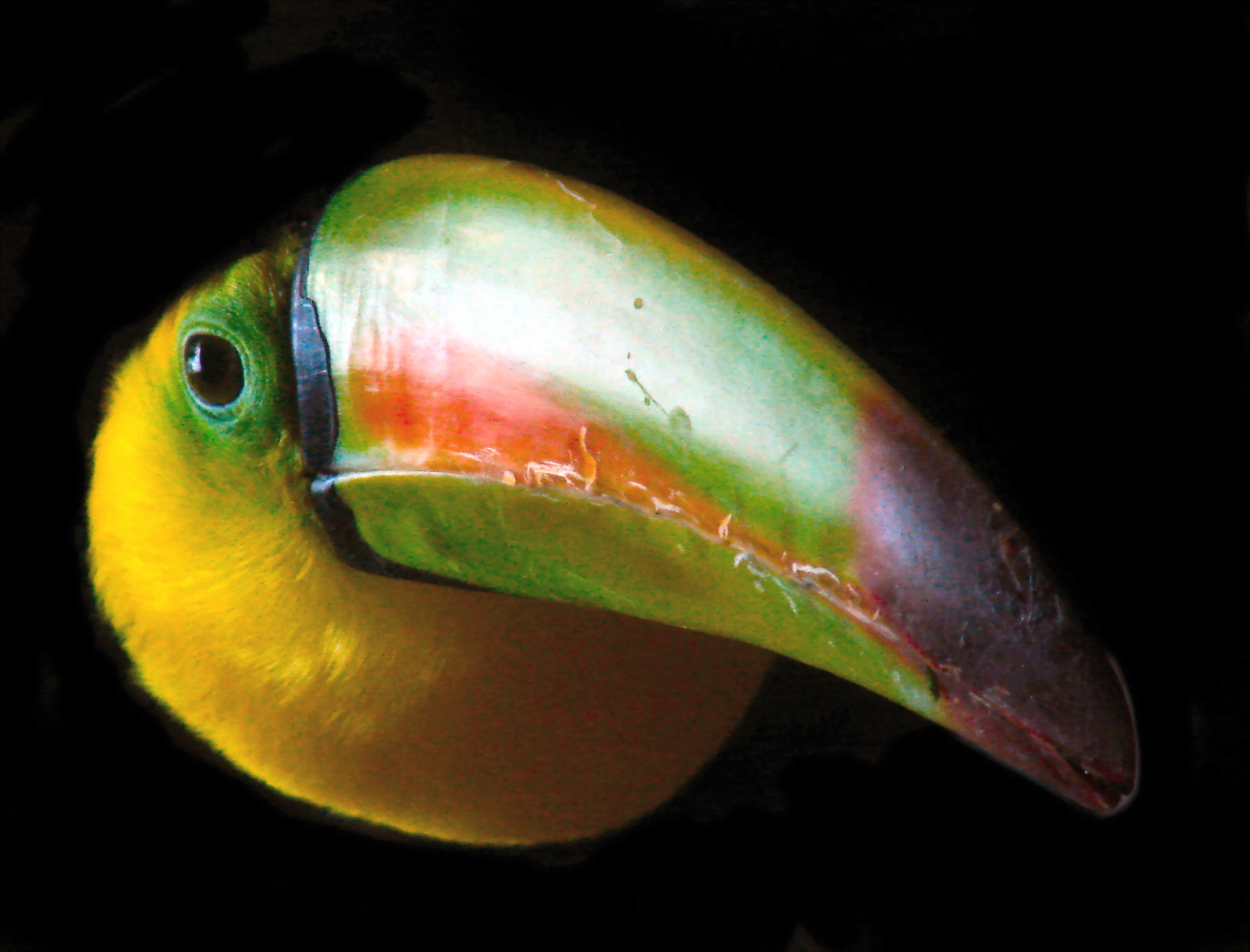| New Photos | Animal News | Animal Sounds | Animal Movies | Upload Photo | Copyright | Korean |
|---|
| Funny Animal Photos | Monsters in Animalia | Wiki Articles Fun Facts about Animals | Links | Home | Mobile A.P.A. |
|---|
| Image Info | Original File Name: Portrait Of A Keel-billed Toucan (Ramphastos sulfuratus).jpg Resolution: 2021x1540 File Size: 403117 Bytes Date: 2007:05:18 22:04:55 Camera: DSC-H1 (SONY) F number: f/2.8 Exposure: 10/2000 sec Focal Length: 694/10 Upload Time: 2007:12:10 13:02:03 | |
| Author | Name (E-mail): Unknown | |
| Subject | Toucan (Family: Ramphastidae) - Wiki | |
 |
| Email : E-Card | Poster | Web Master Delete Edit Info Admin |
| Description | Toucan (Family: Ramphastidae) - Wiki
Toucan
Toucans are near passerine birds from the neotropics. They are brightly marked and have large, colorful bills. The family includes five genera and about forty different species. Toucans range in size from the Lettered Aracari (Pteroglossus inscriptus), at 130 g (4.6 oz) and 29 cm (11.5 inches), to the Toco Toucan (Ramphastos toco), at 680 g (1.5 lb) and 63 cm (25 inches). Their bodies are short (of comparable size to a crow's) and thick. The tail is rounded, and varies in length from half the length to the whole length of the body. The neck is short and thick, and at the base of the head is a huge, brightly-colored beak that measures, in some large species, more than half the length of the body. A toucan's tongue is long, narrow, grey, and singularly frayed on each side, adding to its sensitivity as an organ of taste. The legs of a toucan are strong and rather short. Their toes are arranged in pairs with the first and fourth toes turned backward. Males and females are the same color. The feathers in the genus containing the largest toucans are generally black, with touches of white, yellow, and scarlet. The underparts of the ara??aris (smaller toucans) are yellow, crossed by one or more black or red bands, and the edges of the beak are saw-toothed. The toucanets have mostly green plumage with blue markings. Toucans are frugivorous (fruit-eating), but will take prey such as insects and small lizards. However, the function of the beak in feeding is not known, since many other birds consume these foods without the giant bill to help them. One likely use is to specialize on prey such as nestlings and bats in treeholes. In this view, the beak allows the bird to reach deep into the treehole to access food unavailable to other birds. They are arboreal and nest in tree holes laying 2???4 white eggs. The young hatch completely naked, without any down. Toucans are resident breeders and do not migrate. Toucans are usually found in pairs or small flocks. The name of this bird group is derived from Tupi tucana, via French. Systematic list Genus Aulacorhynchus - green toucanets (6-13 species, depending on taxonomy) Blue-banded Toucanet (Aulacorhynchus coeruleicinctis) Chestnut-tipped Toucanet (Aulacorhynchus derbianus) Crimson-rumped Toucanet (Aulacorhynchus haematopygus) Yellow-browed Toucanet (Aulacorhynchus huallagae) Emerald Toucanet (Aulacorhynchus prasinus) Wagler's Toucanet (Aulacorhynchus (prasinus) wagleri) Blue-throated Toucanet (Aulacorhynchus (prasinus) caeruleogularis) Violet-throated or Nelson's Toucanet (Aulacorhynchus (prasinus) cognatus) Santa Marta Toucanet (Aulacorhynchus (prasinus) lautus) (North) Andean Toucanet (Aulacorhynchus (prasinus) albivitta) Black-throated or Peruvian Toucanet (Aulacorhynchus (prasinus) atrogularis) Groove-billed Toucanet (Aulacorhynchus sulcatus) Yellow-billed Toucanet (Aulacorhynchus (sulcatus) calorhynchus) Genus Selenidera - dichromatic toucanets Guianan Toucanet, Selenidera culik Tawny-tufted Toucanet, Selenidera nattereri Gold-collared Toucanet, Selenidera reinwardtii Langsdorff's Toucanet or Green-billed Toucanet, Selenidera (reinwardtii) langsdorffii Gould's Toucanet, Selenidera gouldii - sometimes included in S. maculirostris Spot-billed Toucanet, Selenidera maculirostris Yellow-eared Toucanet, Selenidera spectabilis Genus Andigena - mountain-toucans Grey-breasted Mountain-toucan Andigena hypoglauca Hooded Mountain-toucan, Andigena cucullata Plate-billed Mountain-toucan, Andigena laminirostris Black-billed Mountain-toucan, Andigena nigrirostris Genus Pteroglossus - aracaris (14 species, incl. Saffron Toucanet) Lettered Aracari, Pteroglossus inscriptus Green Aracari, Pteroglossus viridis Red-necked Aracari, Pteroglossus bitorquatus Ivory-billed Aracari, Pteroglossus azara Brown-mandibled Aracari, Pteroglossus mariae Chestnut-eared Aracari, Pteroglossus castanotis Black-necked Aracari, Pteroglossus aracari Collared Aracari, Pteroglossus torquatus Fiery-billed Aracari, Pteroglossus frantzii Stripe-billed Aracari, Pteroglossus sanguineus Pale-mandibled Aracari, Pteroglossus erythropygius Many-banded Aracari, Pteroglossus pluricinctus Curl-crested Aracari, Pteroglossus beauharnaesii Saffron Toucanet, Pteroglossus bailloni Genus Ramphastos - typical toucans (about 10 species) Keel-billed Toucan, Ramphastos sulfuratus Choco Toucan, Ramphastos brevis Channel-billed Toucan, Ramphastos vitellinus Citron-throated Toucan, Ramphastos (vitellinus) citreolaemus. Ariel Toucan, Ramphastos (vitellinus) ariel Yellow-ridged Toucan, Ramphastos (vitellinus/ariel) culminatus Red-breasted Toucan, Ramphastos dicolorus Chestnut-mandibled Toucan, Ramphastos swainsonii Black-mandibled Toucan, Ramphastos ambiguus White-throated Toucan, Ramphastos tucanus Red-billed Toucan, Ramphastos (tucanus) tucanus Cuvier's Toucan, Ramphastos (tucanus) cuvieri Toco Toucan, Ramphastos toco Toucans in fiction Toucan Sam, mascot of Froot Loops cereal. Tookie Tookie, George's pet Toucan from George of the Jungle. A humorous derivation of the name of the bird features in David McKee's children's book "Two Can Toucan". Se??or Tuc??n, the Spanish-speaking toucan from the American cartoon Dora the Explorer. Wulffmorgenthaler comic strip features a character named 'Toucan kid', who is an offspring of a human and a toucan. The character Lupe Toucan from My Gym Partner's a Monkey The character Poco from the American cartoon Maya and Miguel. In The Legend of Zelda: The Wind Waker, the Wizzrobe, a magician-like monster that dates back to the first game for the NES, highly resembles a slightly anthropomorphic toucan, possessing the brightly colored beak, and wing-like sleeves on its robe. A joke in the Emperor's New School. "If you can speak toucan, can you also speak threecan and fourcan?" http://en.wikipedia.org/wiki/Toucan
| |||
| Copyright Info | AnimmalPicturesArchive.com does not have the copyright for this image. This photograph or artwork is copyright by the photographer or the original artist. If you are to use this photograph, please contact the copyright owner or the poster. |
|
|
|
| |||||||
| CopyLeft © since 1995, Animal Pictures Archive. All rights may be reserved. | ||||||||
Stats